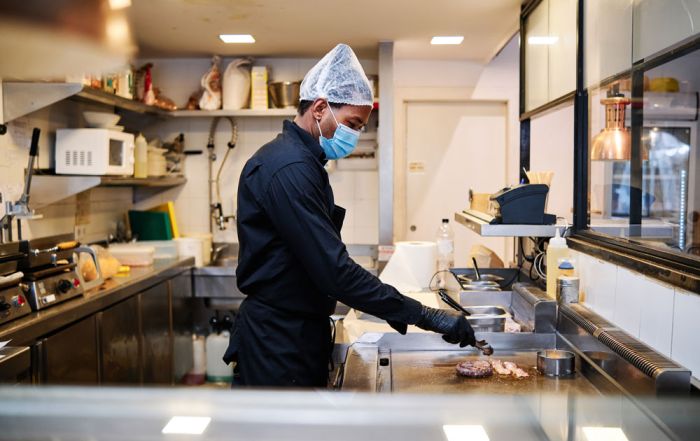The Critical Role of Staff Training and Education in Food Safety for Foodservice Professionals
In mid-June, my colleagues and I at Kansas State University offered our Serving up Science: The Path to Safe Food in Schools course. The course was sponsored by the United States Department of Agriculture Food and Nutrition Service and has brought 50+ school foodservice professionals to campus each year over the last several years to learn about food safety from food safety experts. It was bittersweet because it was our last offering of the course, but we’ve been fortunate to train almost 650 individuals from almost all 50 states and each of the US outlying islands.
As we concluded the week-long session, I began reflecting on the importance of continuing to learn – whether it is about food safety or anything in our lives. In the food safety environment, staying updated on industry trends, best practices, and technological advancements is essential for maintaining high standards. Ongoing learning enables foodservice employees to better adapt to changing regulatory requirements and emerging challenges – such as sesame being added to the list of most common allergens in the US, making the Big 8 the new Big 9.
In higher education we refer to it as “life-long learning”, but whatever you call it, continuous learning fosters innovation, improves problem-solving skills, and enhances job satisfaction. Employees feel more empowered to contribute to the organization and their work teams in meaningful ways.
Continuing to train and educate staff about food safety is an important aspect of developing and maintaining the culture of safe food that we so often discuss in the food safety world. Regular training ensures that employees remain informed about best practices and industry standards, equipping them with the skills needed to handle food safely, minimizing the risk of contamination and foodborne illnesses. By reinforcing proper hygiene, safe food handling techniques, and effective sanitation practices, ongoing education instills a culture of vigilance and responsibility among your staff.
… continuous learning fosters innovation, improves problem-solving skills, and enhances job satisfaction.
My hope is that this continuous training and reinforcement will help your staff develop good food safety habits, like properly hand washing. Habits can become an important part of our daily lives and in the context of food safety, can help us truly create the food safe culture that we need to effectively change employee behavior. One of my favorite quotes is by Tony Dungy, the famed NFL coach, who said, “champions don’t do extraordinary things, they do ordinary things, but they do them without thinking, too fast for the other team to react. They follow the habits they’ve learned.”
They follow the habits they’ve learned…everything comes back to what your employees have learned. Don’t let those habits they demonstrate in your business be the bad habits they brought with them from their previous employer. Or the habits they brought with them from home because they have never worked in a foodservice operation before.
Utilize continuous education and training as a proactive approach to food safety. It does not need to be a full 8- or 16-hour food safety class; it may just be a quick 5- to 10-minute pre-shift meeting or maybe an hour-long seminar. And remember, food safety training and education doesn’t always need to be about the nuts and bolts of food safety, in other words, it doesn’t always need to be the tried-and-true food safety topics we’ve all come to know – how to wash your hands, when to wash your hands, correct end-point cooking temperatures, etc. It might be a local health inspector discussing how they conduct a food safety investigation when an outbreak occurs. It might be a local farmer discussing the food safety practices they implement on the farm to protect food before it comes it your back door. It might be a person in the community sharing how a foodborne illness impacted their family.
While the nuts and bolts of food safety are important, sometimes it’s these other discussions about food safety that cause true behavior change in employees that ultimately improves compliance with food safety recommendations. That continuous learning also demonstrates your support of food safety and cultivates a culture of excellence and accountability that can permeate all aspects of your business. Risk Nothing.
READ MORE POSTS
Hot off the Press: The 2022 Model Food Code has been Released! Part One.
It has finally arrived! Yes, the new year has arrived – but I was not referring to it. I was referring to the new 2022 Model Food Code (10th edition) that has been released by the Food and Drug Administration. I thought I might take this blog and the next blog to discuss some of the changes that have been made to the Food Code that you might see coming your way in the next few years.
Is a Food Safety Culture on your New Year’s Resolutions List?
We hope you all had a wonderful Holiday season and are getting ready for a great new year!
Don’t Underestimate the Importance of Employee Health as we head into the Winter Months
Early this month, I ran across an article discussing an outbreak investigation in the Australian Capital Territory. The outbreak caused more than 200 people to fall ill and was one of the most widespread outbreak investigations in the history of the territory. The cause was traced back to Norovirus, a virus I am sure you have heard us opine about in this blog before.
Exclusion and Restrictions: Understanding Employee Health and the Food Code
I received a call earlier in the month from a foodservice operator who suspected that one of their employees may have fallen ill and wondered if they had to send the employee home for the day. Once I started to ask a few more questions, it became obvious that the operator wasn’t really in-tune with the food code requirements on restrictions or exclusions for employees who may not be feeling well. Given that most operations are dealing with staff shortages currently and the fact that we are about to head into the fall and winter – when we tend to see an increase in upper respiratory and other illnesses, such as the flu - it seemed like a very timely and important topic for the blog this month.










